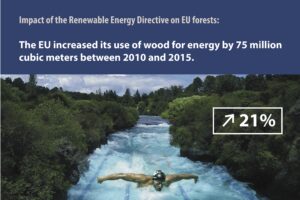A new EU Framework for Forest Monitoring and Strategic Plans of EU Forests
Article by Erica Gentili, Junior Communications Officer for BirdLife Europe
As part of the Forest Strategy for 2030, the European Commission published a new proposal for Forest Monitoring and Strategic Plans of EU Forests in 2023. This proposal aims at “developing an EU-wide forest observation framework to provide open access to detailed, accurate, regular, and timely information on the condition and management of EU forests, and on the many products and ecosystem services that forests provide”1.
As Birdlife, we participated in the feedback consultation on the proposal as we strongly support this new framework. In the scope of the current ecological crisis, the law is essential to make sure of an effective implementation process of the existing legislation and the commitments taken by Member States. This article examines the pressing need for improved forest monitoring, the potential of the proposed framework, and areas that need to be refined.
The state of EU forests: why we need monitoring so bad
Despite an increase in forested areas2, the quality of the European Union’s forests is declining due to climate change and harmful management practices3. One of the fundamental issues starts with the definition of forests which includes non-native plantations and tree-less areas, all leading to misleading data. To effectively address the challenges that come from climate change and harmful management practices, we need harmonised data and improved monitoring systems.
However, existing forest monitoring data in the EU lacks consistency, detail, and standardised collection methods. These disparities need the consolidation and compliance of data to provide a comprehensive understanding of forest ecosystems. Accessible data is essential for all stakeholders involved in forest management to deliver diverse ecosystem services.
The proposed framework: enhancements and suggestions
The proposal rightfully builds on existing monitoring initiatives and aims at enhancing them. The framework ensures comparability between Member States, improves monitoring systems, prevents duplication with other legislation, and incorporates remote sensing data collection. Not to forget the importance of the proposal in aligning with the goals of the Green Deal and the EU Forest and Biodiversity Strategy.
The importance of economic aspects and wood flows, highlighting the need for traceability and tracking of financial flows, is present in the proposal, but the report falls short on the inclusion of additional indicators like naturalness of composition, carbon stock, origin of forests, certification, ecosystem services evaluation, and restoration needs, which are indeed desperately needed. Furthermore, the mapping of old-growth forests should be expedited, and a more detailed, EU-wide definition of old-growth forests should be developed.
The proposed framework also increases transparency by making forest monitoring data publicly available. It provides harmonised data on forest ecosystem integrity, management, health, and carbon stock, including landscape-level information like connectivity. Whilst all this is undoubtedly positive, the addition of a specific provision on improving public access to forest management plans could be beneficial.
Challenges and potential improvements
While BirdLife’s assessment of the proposed law is largely positive, it is important to highlight the need for mandatory long-term forest plans and strategic action based on collected data. Additionally, the inclusion of a Forest Bird Index is very much welcomed, but more attention should be given to the non-tree elements of forests such as soil type, carbon content, and water regime.
The proposed Framework for Forest Monitoring and Strategic Plans holds great promise in addressing the ecological crisis faced by European forests. By consolidating and harmonising monitoring data, enhancing transparency, and incorporating various indicators, the framework can improve forest management and contribute to the EU’s environmental goals. With necessary enhancements and considerations, this proposal can ensure the vitality and resilience of Europe’s forests as essential ecosystems.
[2] Eurostat, “Forests, forestry and logging” (2021) < Forests, forestry and logging – Statistics Explained (europa.eu) > (last accessed 25 January 2024)
[3] Raihan, Asif, “Sustainable Development in Europe: A Review of the Forestry Sector’s Social, Environmental, and Economic Dynamics” (2023) 2(3) Global Sustainability Research, p.72




